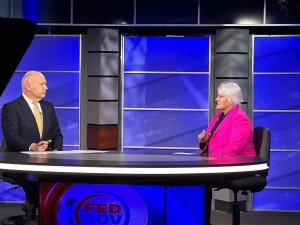Enhancing Digital Government: Clare Martorana on Digital-First Public Experiences and Collaborative Service Delivery
 In an interview with Francis Rose on "Fed Gov Today," Clare Martorana, the Chief Information Officer of the United States, discussed the new guidance from the Office of Management and Budget for delivering digital-first public experiences. This guidance aims to provide a roadmap for both federal agencies and vendors to enhance digital experiences and service delivery. Martorana emphasized the importance of partnership, collaboration, and consistent interaction across government agencies, leveraging the US Web Design System, and focusing on modern, agile, and human-centered approaches. She also stressed the need for a skilled workforce capable of implementing these digital strategies effectively.
In an interview with Francis Rose on "Fed Gov Today," Clare Martorana, the Chief Information Officer of the United States, discussed the new guidance from the Office of Management and Budget for delivering digital-first public experiences. This guidance aims to provide a roadmap for both federal agencies and vendors to enhance digital experiences and service delivery. Martorana emphasized the importance of partnership, collaboration, and consistent interaction across government agencies, leveraging the US Web Design System, and focusing on modern, agile, and human-centered approaches. She also stressed the need for a skilled workforce capable of implementing these digital strategies effectively.
Key Takeaways
- Digital-First Roadmap: The guidance serves as a ten-year roadmap for contractors and agencies, focusing on creating seamless and secure digital experiences without relying on external microsites or disparate digital solutions.
- Emphasis on Open Source and Collaboration: The US Web Design System, an open-source framework, is central to ensuring consistent digital interactions across government agencies. Martorana highlighted the role of contractors in contributing to and benefiting from this shared repository.
- Workforce Development and Agile Approaches: A significant part of the strategy involves upskilling the current government workforce and attracting new talent from various sectors. This approach supports a more agile, collaborative, and effective method in technology implementation and service delivery.
Bridging Generational Gaps in Government Tech: Joe Jeter on Customer Experience and Digital Innovation
 In an interview with Francis Rose, Joe Jeter, Senior Vice President for Federal Technology at Maximus, discussed the challenges and strategies for enhancing customer experience across federal agencies. He highlighted the generational diversity in technology preferences and access, with younger people preferring digital-first interactions and older generations more comfortable with traditional methods like phone calls. To address this, Jeter emphasized the importance of human-centered design, focusing on outcomes rather than specific technologies. He also discussed the role of AI in customizing user experiences and the need for robust cloud and cybersecurity infrastructure to support these initiatives.
In an interview with Francis Rose, Joe Jeter, Senior Vice President for Federal Technology at Maximus, discussed the challenges and strategies for enhancing customer experience across federal agencies. He highlighted the generational diversity in technology preferences and access, with younger people preferring digital-first interactions and older generations more comfortable with traditional methods like phone calls. To address this, Jeter emphasized the importance of human-centered design, focusing on outcomes rather than specific technologies. He also discussed the role of AI in customizing user experiences and the need for robust cloud and cybersecurity infrastructure to support these initiatives.
Key Takeaways
- Generational Diversity in Tech Preferences: Agencies face the challenge of catering to a wide range of preferences, from digital-first younger generations to older ones accustomed to traditional communication methods.
- Human-Centered Design Focus: Successful agency strategies start with user-centered design, considering various modes of interaction (phone, digital, hybrid) and focusing on the desired outcomes for different user groups.
- Role of AI and Infrastructure: AI plays a critical role in personalizing customer experiences, supported by a strong underlying infrastructure of cloud computing and cybersecurity. This approach allows for efficient and secure customization of services for diverse user needs.
Advancing Air Force Technology: Venice Goodwine on Strategic Priorities and Enhancing Warfighter Capabilities
 Venice Goodwine, the new Chief Information Officer at the Air Force, discussed her focus on six lines of effort to enhance technology provision for Airmen and guardians. These efforts align with Secretary Kendall's initiative on great power competition, emphasizing decision advantage through data and AI, efficient use of existing investments, robust cybersecurity, and a skilled workforce. Goodwine elaborated on the importance of data availability and trustworthiness, facilitated by cloud capabilities and joint contracts. She also stressed the need for a versatile workforce skilled in cybersecurity and data science, and the significance of enhancing user experience, including adapting to a digital workforce and ensuring cybersecurity through zero-trust models.
Venice Goodwine, the new Chief Information Officer at the Air Force, discussed her focus on six lines of effort to enhance technology provision for Airmen and guardians. These efforts align with Secretary Kendall's initiative on great power competition, emphasizing decision advantage through data and AI, efficient use of existing investments, robust cybersecurity, and a skilled workforce. Goodwine elaborated on the importance of data availability and trustworthiness, facilitated by cloud capabilities and joint contracts. She also stressed the need for a versatile workforce skilled in cybersecurity and data science, and the significance of enhancing user experience, including adapting to a digital workforce and ensuring cybersecurity through zero-trust models.
Key Takeaways
- Comprehensive Strategy for Great Power Competition: Goodwine's strategy is deeply intertwined with Secretary Kendall's initiative, focusing on preparing the Air Force for great power competition through advanced technology and data capabilities.
- Emphasis on Efficient Investment and Cybersecurity: The approach includes maximizing current investments and strengthening cybersecurity to protect critical infrastructure and data.
- Workforce Development and User Experience: There's a strong focus on recruiting and retaining skilled personnel, particularly in data science, and enhancing the user experience through modernized IT infrastructure and cybersecurity measures like zero-trust.

-1.png?width=980&height=90&name=FGT%20728%20x%2090%20px%20(980%20x%2090%20px)-1.png)
Please fill out the requested information below